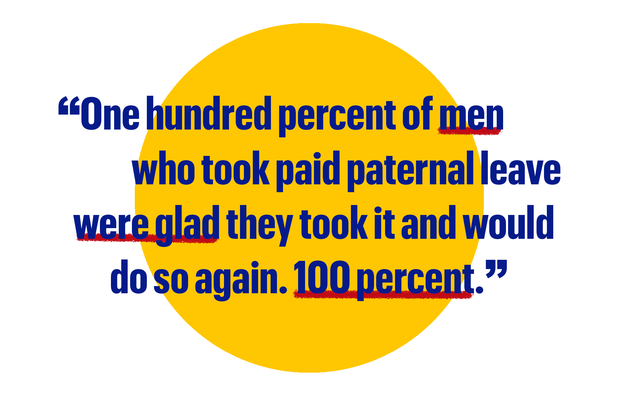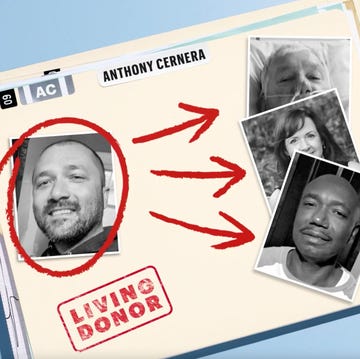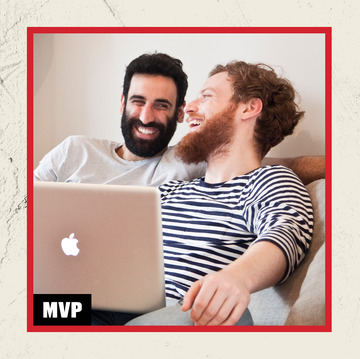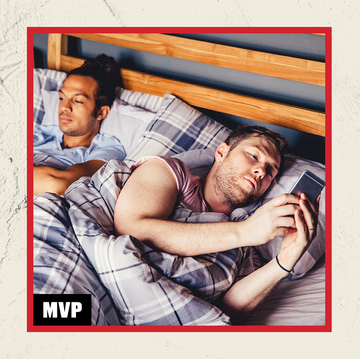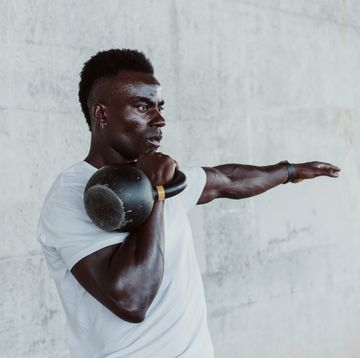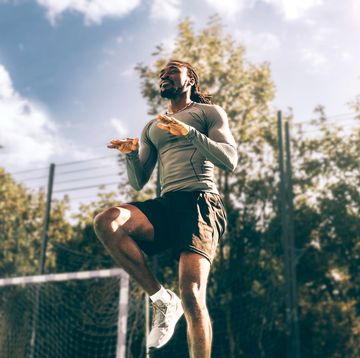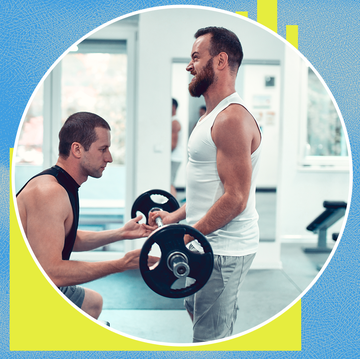I HAD DISCOVERED THE secret too late, unfortunately. I was on my eighth and final week of paternity leave with my daughter, Matilda, who had been diagnosed with acid reflux—a common occurrence in three-month-olds.
Her condition caused her to spit up frequently and massively. If I wasn’t quick enough to reposition her trajectory so that the gastroesophageal reflux would hit the floor, she’d puke on my shorts. The floor is easy to clean. My shorts, I was finding, were not. Plus, I had an abundance of flooring. Shorts were less plentiful.
One day, shorts-less, I pulled out a pair of swim trunks. “These could be mistaken for shorts,” I might of said to myself, but also out loud, because an extended bout of paternity leave does things to you, man. “Plus, who the hell am I actually going to see today?”
More From Men's Health

And, mere moments later, Matilda’s spit-up spewed forth onto my swim trunks, where the slick, waterproof fabric sent it flying to the floor. With a swipe of a rag, my trunks were (relatively) clean.
This may not sound like a huge deal to you, but it changed the remaining days of paternity leave. It was one of the many discoveries that made leave just a little bit more enjoyable.
I took my paternity leave with Matilda right around that magical three-month marker when babies learn to smile, a great stage for a father because before that, all infants do is look at you and realize you’re not a breast and then look away. Smiling is something, but unfortunately not enough to get you through weeks on end with a helpless (and, in my case, slippery) blob of baby.
I did have some experience. Our first child garnered me a mere two weeks of leave (see, times are changing) instead of 10. Maybe some of my dormant dad abilities from that stint would kick in. But like any new parent, I knew I was going to have to learn my lessons through trial and spit-up-covered error.
The discoveries that follow go far beyond wearing a swimsuit. They’re insights on paternity leave from dads who’ve learned through experience, like I did, about how to make the experience more efficient, more special, and generally a lot more awesome.
1. Actually Take Your Paternity Leave
Studies show that new parents who take paid parental leave have healthier, happier infants—and the parents themselves are less likely to suffer mental health issues later in life. Yet, compared to mothers, fathers take relatively little time off after the birth of a kid, according to the U.S. Department of Labor.
Nine out of ten U.S. fathers do take some time off work for birth or adoption, but 70 percent of fathers take ten days of leave or less, according to that DOL report. One reason is that many companies simply don’t offer the benefit yet. But more companies and more states are now starting to offer longer paid paternity programs. Federal legislation is also in the works.
At the risk of this descending into a PSA, if your company or state of residence offers paid leave—take it. The Family Medical Leave Act prohibits employers from discriminating or harassing you if you take leave.
If you’re worried that you’ll be hindered professionally, the research there is admittedly complex. While a 2020 McKinsey & Company survey of 130 new fathers found that of the new dads who said a career setback was their main worry of taking leave, most of them said the perceived career benefits outweighed the risks. Unfortunately, the research field is still so new that no real studies have shown any kind of job benefit to taking paternity leave—but not everything is (or should be) about your job, as I soon discovered.
And consider that the same survey found that 100 percent of men who took paid paternal leave were glad they took it and would do so again. 100 percent.
So regardless of how much your company gives you—two weeks, ten weeks, 20 weeks (what, do you live in Sweden?)—take it.
2. Give Work a Heads Up
Andreas Kitzing is the CEO of Sponsoo, a start-up based in Germany. Kitzing recently finished the first part of his paternity leave a few months ago.
Given his responsibilities as CEO, Kitzing says he did have to check in at work while he was on leave, but dialed back the amount of work to about 30 percent.
He did this, he says, by setting expectations.
“I made it clear to everyone that taking care of my family was the top priority,” Kitzing says. “Because I communicated with my team openly and I got the approval of the shareholders beforehand, I was much less stressed because everyone knew what the situation was.”
For internal meetings, he says he let his team know he might be interrupted or need to postpone if family matters arose. External meetings, he says he minimized. And the baby’s nap time was his email time. “I used the plan sending feature of Gmail often,” Kitzing says, so he wasn’t interrupting people at odd hours of the night.
I didn’t check email on my leave, but I know that’s not something everyone can do. But Kitzing is proof that you can at least prioritize your family to the extent that you can work less (and carry less work stress).
3. Think of It as “Family Leave”
Paternity leave implies that it’s just you and the baby. Reframe the experience with your entire family in mind. Your partner will need support. Your other children, whether you have one or six, will need time adjusting. Your extended family will be eager to see and squeeze and take 400 of the same photos of the baby. You are there for all of them. Savor it.
“There aren’t many times that you get to spend this much time with your family,” says Nathaniel Popper, finance and technology reporter for The New York Times. “To be there during all the moments of the day—even during vacation that can be hard.”
Popper took 10 weeks paternity leave in 2017 after the birth of his second child. “It’s an unusual experience to be going through something that is hard, where everybody is having their challenges. But you have a time to sit with that, which is not usually the case.”
“Whatever you’re doing at work is probably less singular than you think and certainly less singular than time your family,” Popper says.
So plan fun family weekends. Take your older kid to the playground, just you and them, after school during the week for some quality one-on-one bonding. Schedule lunch once a week with a friend or family member who wants to see the baby and, go on, let them take 400 of the same photos of the baby.
And also don’t forget about yourself.
4. Build Your “Summer of George” List
You know the Seinfeld episode. George Constanza gets fired from the Yankees and has three months off. So he makes a list of things he’s always wanted to do (playing frolf, attending a tractor pull, biting into a hunk of cheese) and proclaims it his “Summer of George.”
Constanza wasn’t encumbered by a diaper-wearing infant, but his proclamation rings true for paternity-taking dads. The baby will nap. The baby is portable. The baby can be placed in a safe location and rudimentarily entertained for brief stretch of time. You will be tethered, but not chained.
Before and during paternity leave I maintained a “(maybe) to-do list” of what I determined to be achievable goals. I had never seen all three Back to the Future movies in full. I finally watched them (albeit in 15- to 25-minute chunks). I listened to a Phillies game on the radio. I took Matilda on an epic stroller walk to a get an ice cream cone and back. During one of my daughter’s particularly long naps, I planted a pollinator garden in the backyard.
One important note on “maybe”. Knowing myself, I set my expectations low. If I didn’t get around to completing a project, such as painting my son’s room, because I had to meet Matilda’s needs, I had to be okay with that. The last thing I ever wanted was for me to resent Matilda because of Marty McFly.
5. Make Some Fitness Adjustments
You know your whole hour-long workout routine? Yeah, that’s going to have to wait.
“Most days just going for a run around the neighborhood was the best I could do,” says Texas Congressman Colin Allred, who in 2019 became the first known member of Congress to take paternity leave. For Allred, that was a huge shift: Prior to his political career he played four years in the NFL with the Tennessee Titans.
But it wasn’t about just physical fitness. “I didn’t run as fast or as far as I normally would, and I don’t think it was even that useful from a fitness perspective,” he says. “But those runs were essential from a mental health standpoint.”
The most important part was just doing something. “I tried to find some kind of exercise every day—a point in the day to let my mind not have to think about childcare,” says Allred, who says he has even held his baby when he was on his home stationary bike.
Personally, I took to “fitness snacking”—short bursts of activity I could intersperse throughout my day if my daughter was napping, rolling on the playmat, or in her play gym. Each day I’d aim for 100 pushups, 100 minutes of planks, and 100 bicep curls. I wouldn’t say it helped me grow stronger, but it definitely helped prevent strength and muscle loss. In paternity leave, maintenance is a win.
6. Chunk Up the Day
“Babies are on their own schedule,” says Allred. “You have to bend to their schedule or you’ll break.”
I like that word “bend.”
I learned over the first week what times during the Matilda ate, slept, needed to get out of the house, and was just generally fussy. But I also learned that I couldn’t just hang on as Matilda moved through the day. I realized I had to bend in order to keep things interesting for her and myself.
So the period between Matilda’s first and second nap became her “workout,” where she tummy-timed and batted at toys on her playmat, a space I dubbed her “Plastic Paradise.” The time between her second and third nap was “sensory time,” where we moved about the yard, read books, and listened to music. The afternoon, when she grew fussy, we went for a walk in the stroller.
It became our routine, which I know helped my mental health and hopefully hers too. I swear she still enters her Plastic Paradise with an intensity the likes of which Dwayne Johnson himself would respect.
7. Spend Money on Yourself
Even though paternity leave is not a vacation (despite some people thinking so), like a vacation you need to have the right gear.
Matilda was born in February so I bought a pair of supremely comfortable sweatpants for my initial two weeks of leave. They made waking up in the middle of the night to go comfort her just a little less grueling.
Vitamix sent me their new ONE blender to test—a bare-bones, quieter-than-most, twist-and-blend set-up that was perfect for sleep-deprived breakfast smoothies.
My wife scored a Thule double stroller off Facebook Marketplace that allowed me to walk three-year-old son to daycare with my daughter in the car seat beside him—a proud papa moment.
If there’s something out there you’ve been wanting that you think will make your leave go a little easier, buy it.
8. Rediscover Date Night
One study by researchers Richard Petts and Chris Knoester show that even short periods of paternity leave caused couples’ divorce risk to drop and to remain significantly lower for as many as six years after the birth of the child.
I expected to feel closer to my daughter during my leave, but I didn’t also expect how close I would feel with my wife. Kitzing, the CEO, says he experienced something similar: a focused sense of teamwork.
“I’d regularly check up with my wife to see if there’s anything I could do to help her. I tried to take of cleaning and tidying up. We went through the experience of having a newborn as a couple, not just as two individuals.”
Helping is one way to connect, but so is getting someone to watch the kid(s) and going out to have a meal somewhere. (Remember that?)
My wife and I went on a date once a month. I set the plans. I arranged the sitter. And then we made it happen. And each time we did, the days afterward felt a little more manageable, as if reinforcing our foundation improved the strength of the home life we were building upon.
9. Submit—and Succeed!
At some point—and likely at many points—during paternity leave, a voice may emerge in your head: I don’t want to be doing this right now.
I heard this voice washing bottles, cleaning up yet another splatter of spit-up, trying to re-shush Matilda back to sleep after she woke up from a crummy nap, and fighting off my own nap as she completed a few more reps in her Plastic Paradise.
But to fight is to resist, and to resist is to try and exert your will over a creature so tiny is missing the point.
Family life succeeds when it operates as a unit.
“Our roles sort of disappeared,” says Congressman Allred, in reference to he and his wife. “My wife was nursing so I had to find where I could be helpful. I could do bottles, change diapers, get up at night. Babies are no different than any other challenge, you just have to put the time and effort.”
And there’s a benefit to submission: experiences gained.
“Any hesitation I had around changing diapers or the grosser parts of having a child, that goes away quickly. It becomes a non-issue. In fact, I was puked on earlier before this interview,” Allred says.
What forms is a sense of: “I can do this.”
And then, once your paternity leave is complete, something even grander: “I did that. Now, what else can I do?”

Paul is the Food & Nutrition Editor of Men’s Health. He’s also the author of two cookbooks: Guy Gourmet and A Man, A Pan, A Plan.


